乔布斯的演讲秘诀
乔布斯提升演讲肢体语言效果的三大技巧 (2)

乔布斯提升演讲肢体语言效果的三大技巧乔布斯是一位在演讲界备受赞誉的人物。
他凭着自己敏锐的洞察力和优秀的演讲技巧,成功地将他的公司苹果电脑推向了全球榜首的地位。
他的演讲赢得了无数的粉丝和受众,而他的肢体语言更是倍受称赞。
事实上,乔布斯所表现的肢体语言效果常常被誉为演讲中最为重要的元素之一。
本文将介绍乔布斯使用的三个技巧,这些技巧是乔布斯大师级的肢体语言效果的关键。
1. 用手势举例子乔布斯在演讲过程中,善于使用手势来进行举例说明。
他会用手指来表示一个数字或者大小,还会用手指画图来解释一些概念。
这样的肢体语言效果非常直观,无须过多的文字解释,便可以让听众更好的理解他正在讲述的内容。
在这个技巧中,重要的是要注意手势的细节和动作的明确性。
这样才能达到最佳的效果。
2. 利用眼神交流乔布斯司空见惯的演讲技巧之一就是利用眼神交流。
他常常直视观众,并且不断地与他们进行交流。
这样的眼神交流消除了任何形式的隔阂,使得演讲效果更加出色。
这个技巧在演讲中尤为重要,因为听众必须觉得他们是被听到的并且被尊重的。
如果演讲者漫不经心的演讲,缺乏眼神交流,听众就会感到演讲者并不在意他们的存在。
这个技巧的基本要点是与观众建立稳固的联系,以获得他们的信任和支持。
3. 利用肢体语言强化讲述乔布斯的肢体语言效果最出名的一个方面就是他用身体语言强化说话的内容。
在演讲的过程中,他常常加入自己的动作和姿势来增加讲述的效果。
比如在演示新产品或功能时,他会身体一侧,强调谈话的重点,还会抬起手臂来强调要点。
这样的姿势在演讲中非常重要,因为它们可以使讲述更加生动、有趣,同时还可以增加说话的说服力。
有时候,乔布斯也会用肢体语言强化一些情感表达。
如果他想表达自己对某项计划的兴奋,他会站起来,并摇晃手臂以表达他的激动。
同样地,如果他想表达对某个问题的反对,他会抬起双手,作出一个停止的手势,来表达他的态度。
总的来说,肢体语言在演讲中至关重要。
乔布斯的肢体语言效果的影响力就在于他强调了身体动作的重要性,并巧妙地将它们与他的讲述结合在了一起。
名人乔布斯演讲技巧

名人乔布斯演讲技巧名人乔布斯演讲技巧名人演讲一般很受欢迎,今天店铺跟大家分享的是乔布斯的演讲技巧。
乔布斯是苹果公司的创始人,苹果手机是世界上最著名的手机,这离不开乔布斯的商业推广,那么乔布斯是怎么推广发布他的新产品的呢,下面和yjbys店铺一起看看吧!If you really want your presentation to pop, treat it like a show, with heads and flows and themes and transitions.如果你真的想要演讲出类拔萃,就把它当作一场演出,各种标题、流程、主题和过渡。
Jobs includes video clips, demonstrations and guests.乔布斯用到了包括视频剪辑、样品展示和客串嘉宾。
He also has a knack for dramatic flair and it's very effective.他有时还具有戏剧性的天赋本领,而且非常有效。
For example, when introducing the Mac Book Air, Jobs drew cheers by opening a manila inter-office envelope, holding the laptop out for everyone to see.比如在推广Mac Book Air时,乔布斯打开了一个马尼拉纸制的办公室间的信封,举起了这款笔记本电脑给大家看,观众们立马喝彩。
This is the new Mac Book Air.这就是新款Mac Book Air,You can get a feel for how thin it is.你可以感受一下它有多薄。
What is the only one memorable moment of your presentation?你演讲中最难忘的一个瞬间是什么?Identify it ahead of time, then build up to it.之前先确定下那一刻,然后使出浑身解数引向那里。
乔布斯演讲的15个秘诀19页PPT

6、最大的骄傲于最大的自卑都表示心灵的最软弱无力。——斯宾诺莎 7、自知之明是最难得的知识。——西班牙 8、勇气通往天堂,怯懦通往地狱。——塞内加 9、有时候读书是一种巧妙地避开思考的方法。——赫尔普斯 10、阅读一切好书如同和过去最杰出的人谈话。——笛卡儿
Thank you
乔布斯演讲的15个秘诀
26、机遇对于ห้องสมุดไป่ตู้准备的头脑有特别的 亲和力 。 27、自信是人格的核心。
28、目标的坚定是性格中最必要的力 量泉源 之一, 也是成 功的利 器之一 。没有 它,天 才也会 在矛盾 无定的 迷径中 ,徒劳 无功。- -查士 德斐尔 爵士。 29、困难就是机遇。--温斯顿.丘吉 尔。 30、我奋斗,所以我快乐。--格林斯 潘。
乔布斯的演讲秘诀有 乔布斯的17个演讲秘诀1500字
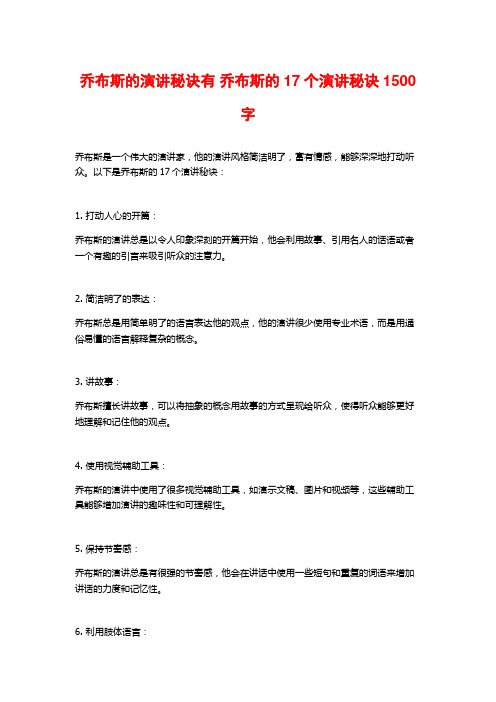
乔布斯的演讲秘诀有乔布斯的17个演讲秘诀1500字乔布斯是一个伟大的演讲家,他的演讲风格简洁明了,富有情感,能够深深地打动听众。
以下是乔布斯的17个演讲秘诀:1. 打动人心的开篇:乔布斯的演讲总是以令人印象深刻的开篇开始,他会利用故事、引用名人的话语或者一个有趣的引言来吸引听众的注意力。
2. 简洁明了的表达:乔布斯总是用简单明了的语言表达他的观点,他的演讲很少使用专业术语,而是用通俗易懂的语言解释复杂的概念。
3. 讲故事:乔布斯擅长讲故事,可以将抽象的概念用故事的方式呈现给听众,使得听众能够更好地理解和记住他的观点。
4. 使用视觉辅助工具:乔布斯的演讲中使用了很多视觉辅助工具,如演示文稿、图片和视频等,这些辅助工具能够增加演讲的趣味性和可理解性。
5. 保持节奏感:乔布斯的演讲总是有很强的节奏感,他会在讲话中使用一些短句和重复的词语来增加讲话的力度和记忆性。
6. 利用肢体语言:乔布斯在演讲中经常运用肢体语言来增加表达的效果,他会走来走去,手势丰富,表情丰富,使得演讲更加生动有趣。
7. 利用幽默感:乔布斯善于利用幽默感来缓解紧张气氛,增加演讲的趣味和吸引力。
他常常在演讲中加入一些幽默的插科打诨,使得演讲更加生动有趣。
8. 强调关键点:乔布斯在演讲中会重复强调一些关键点和重要观点,以便让听众更好地理解和记住他的观点。
9. 创造意象:乔布斯擅长用形象化的语言和比喻来描述他的观点,这样可以让听众更好地理解和记住他的观点。
10. 多样化的声音和语调:乔布斯的声音和语调在演讲中经常发生变化,他会通过改变音调和语速来增加演讲的表现力和吸引力。
11. 利用情感和感情联结听众:乔布斯的演讲总是充满情感,他会毫不保留地表达自己的情感和对产品的热情,从而与听众建立起情感上的联结。
12. 充分准备:乔布斯的演讲从不是即兴的,他会提前准备演讲稿,并进行多次排练,以确保演讲的流畅和清晰。
13. 适应听众:乔布斯的演讲风格可以根据听众的不同需求进行调整,他可以在不同的场合和不同的受众面前使用不同的演讲风格。
魅力乔布斯之演讲技巧
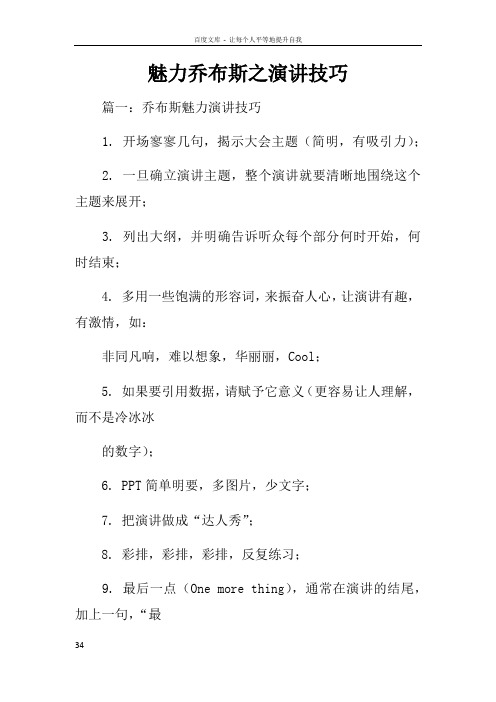
魅力乔布斯之演讲技巧篇一:乔布斯魅力演讲技巧1. 开场寥寥几句,揭示大会主题(简明,有吸引力);2. 一旦确立演讲主题,整个演讲就要清晰地围绕这个主题来展开;3. 列出大纲,并明确告诉听众每个部分何时开始,何时结束;4. 多用一些饱满的形容词,来振奋人心,让演讲有趣,有激情,如:非同凡响,难以想象,华丽丽,Cool;5. 如果要引用数据,请赋予它意义(更容易让人理解,而不是冷冰冰的数字);6. PPT简单明要,多图片,少文字;7. 把演讲做成“达人秀”;8. 彩排,彩排,彩排,反复练习;9. 最后一点(One more thing),通常在演讲的结尾,加上一句,“最后一点”,会让观众觉得他们又多赚了一点。
总结:要赋予演讲一个震撼的开场,一个高潮迭起的过程和一个令人流连的结尾。
篇二:乔布斯如何做到吸引人的演讲的乔布斯如何做到吸引人的演讲的作者:Carmine Gallo苹果公司在三十年里不断创新,它给我们带来了全新体验的计算机并改变了我们聆听音乐的方式。
而极具人格魅力的公司创始人史蒂夫〃乔布斯将公司提升到了一个新的高度。
任何观看过乔布斯演讲的人都会认同,他是美国最为杰出的公司演讲者之一。
乔布期从很早以前就知道,一个领导人必须是该公司的品牌发言人。
作为一个专栏作家和记者,我花了大量的时间来观看乔布斯的演讲。
他真是棒极了。
无伦是发布像iPod那样的电子玩意,还是酒吧三明治,最主要的目的就是要赢得客户。
以下是我从乔布斯演讲中总结出的五个重点,看看他是如何通过演讲技巧来做到这一切的。
*传达“利益”概念乔布斯在演讲中不是在推销商品实物,他传达的是一种体验信息。
乔布斯不像大部分的技术人员,在演讲中充斥着那些令人麻木的数据统计,而是在向听众兜售他们能从新产品中得到何种“利益”!举例来说,在发布30G iPod时,他这样说明这个产品对用户的意义——用户可以随身携带7500首歌曲、25000张照片、或者是长达75小时的视频。
乔布斯在演讲中惯用的五大法门,看完后恍然大悟

乔布斯在演讲中惯用的五大法门,看完后恍然大悟在信息爆炸的今天,想从每天无以数计的杂乱信息中脱颖而出,让大家记住你,甚至对你产生好感,成功的表达都是关键,而演讲的能力,就是最为实用有效的表达能力。
演讲,也不是只局限于灯光舞台一人脱口秀这一种形式。
在人生大舞台上,每次你开口说话的机会,都是演讲的机会,都是有效传达你想传播的信息,运用你的技巧占领对方心智的机会。
今天,我们就来分享商业演说的王者,乔布斯的演讲诀窍。
就是这些简单技巧的合理使用,让它之前的每次产品发布会都成为了科技演讲的经典。
1、传达"1"个核心信息。
科学家研究发现,人类的大脑有个明显的缺陷,就是同一时间无法深层的储存很多信息。
如果一个人在短时间内接触到很多信息,他的大脑往往只能进行浅层记忆处理,这些只在浅层储存的信息,可能很快就会被新的信息覆盖掩埋无从想起,在大量信息同时进驻的时候,很多时候一个信息都无法进入深层记忆。
因此,成功演讲的第一个关键,就是每次只传达一个核心信息,或者只重点传达一个核心信息,通过在一次演讲内对这个核心信息的重复多次传达,让听众深层的记住这个信息,让听众在大脑中建立你所讲的事物跟这个核心信息的指代性重度关联,即以后一想到这个事物,马上想到这个核心信息。
乔布斯在Macbook Air的产品发布会上,不厌其烦的重复了几十遍一个信息"世界上最轻薄的笔记本电脑",在之后的营销宣传中也无处不在的强调这个信息,成功的让消费者记住了这个乔布斯想要大家建立的强认知"MacBook Air就是世界上最轻薄的电脑"。
在iphone的产品发布会上,他传达的核心信息是"今天,苹果重新发明了手机"。
所有的消费者也记住了这个信息"苹果手机就是不同以往的新发明"。
2、建立听众的共鸣。
演讲的另一大诀窍,建立听众的共鸣。
没有经验的演讲者最常犯的错误之一,就是只讲自己在乎的想讲的,一切从自己出发表达,而忘了听众才是关键,如果你讲的对听众来说无关又无味,你讲得再多他们都没听进去,那这次演讲就毫无意义。
乔布斯提升演讲效果的七大技巧_1
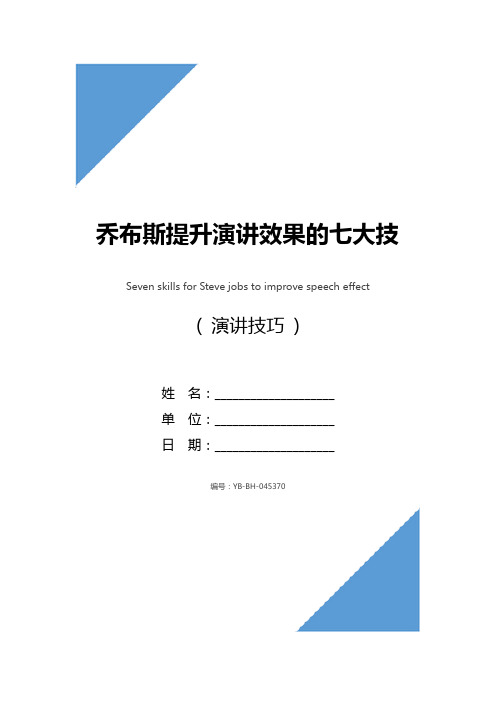
( 演讲技巧)姓名:____________________单位:____________________日期:____________________编号:YB-BH-045370乔布斯提升演讲效果的七大技Seven skills for Steve jobs to improve speech effect乔布斯提升演讲效果的七大技巧沟通的效果,不仅仅取决于我们说话的内容,更取决于我们说话的方式。
下边我们详细解读商界领袖乔布斯的经典形象,更好地欣赏他的演讲技巧——提升肢体语言效果的三大技巧乔布斯登台演讲时,总是热情洋溢,看起来似乎有无穷无尽的精力。
当他的情绪处于最佳状态时,有三件事贯穿乔布斯演讲的始终,任何人都可以学习这三项技巧,以提升自己的演讲和表达能力。
这三大技巧是:注重目光交流,保持开放式姿势,并频繁运用手势。
1注重目光交流眼睛是传递非言语信息的最有效的渠道。
乔布斯比一般的演讲者更注重保持目光的接触,他很少在演讲时读幻灯片或注释。
乔布斯并没有完全淘汰注释。
进行示范展示时,他常常会参照事先准备好的注释提示。
如果乔布斯逐字逐句地阅读注释,台下没有人知道,但是,事实上,他一直和听众保持着目光交流。
他会偶尔扫视一张幻灯片,然后迅速将注意力转移到听众身上。
大多数演讲者把太多时间花在逐字阅读幻灯片文本上。
进行示范展示时,平庸的演讲者基本上完全忘却了和听众保持目光交流。
研究发现,目光交流意味着诚实、守信、真诚和信心。
避免目光的接触则意味着缺乏信心和领导能力。
缺乏和听众的目光交流绝对会使你失去听众。
乔布斯之所以能一直和听众进行良好的目光交流,因为他总是提前几个星期就开始排练。
他对每张幻灯片上的内容了如指掌,他排练得越多,演讲的内容就越了然于胸,和听众之间的交流也就更加易如反掌。
使乔布斯和听众保持良好的目光交流的第二个原因是,他的幻灯片令人赏心悦目。
大多数时候,幻灯片上只有寥寥数语,只有照片。
即便有文字,字数也不多,有时只有一个词。
乔布斯黄金圈法则演讲

乔布斯黄金圈法则演讲一、什么是黄金圈演讲法则史蒂夫·乔布斯,一个我们熟知的名字,一位伟大的创新者和演讲家。
他的演讲能力被誉为“现实扭曲力场”,能让听众为之倾倒,为之激动。
乔布斯的演讲技巧被很多人研究,其中最为人津津乐道的便是他的“黄金圈”演讲法则。
黄金圈演讲法则,源自西蒙·斯涅克(Simon Sinek)的“黄金圈理论”,乔布斯将其运用到了极致。
这个法则的核心理念是:人们购买的并非产品本身,而是产品所能带来的感受、信念和故事。
这个理念在乔布斯的每一次演讲中都得到了完美体现。
黄金圈演讲法则分为三个层次:为什么(Why)、如何做(How)和是什么(What)。
这三个层次由内向外扩散,形成了一个黄金圈。
在最内层的“为什么”层,乔布斯总是激情洋溢地阐述他的理念和信仰,他相信每一个产品都能改变世界,都能让人们的生活变得更美好。
他的这种激情和信念,深深地感染了每一个听众,让他们对产品充满了期待。
在中间层的“如何做”层,乔布斯会详细介绍产品的设计、研发和生产过程。
他善于把复杂的技术问题简单化,让人们能理解并接受。
他讲述的每一个细节,都充满了对产品的热爱和对用户的尊重。
在最外层的“是什么”层,乔布斯会自豪地介绍产品的特点和功能。
这个层次的信息最直观,也最容易被人理解。
但是,乔布斯并不满足于仅仅介绍产品的功能和特点,他更希望人们能理解产品背后的理念和精神。
乔布斯的黄金圈演讲法则,其实是一种由内而外的思考方式。
它先从内心的信仰和理念出发,然后向外扩展到具体的行动和结果。
这种思考方式,让乔布斯的每一次演讲都能触动人们的心灵,都能让人们为之激动。
黄金圈演讲法则不仅适用于产品发布、公司介绍等商业场合,也适用于任何需要说服他人、激发他人热情的场合。
它告诉我们,要想打动人心,首先要有一个坚定的信仰和理念,然后才是具体的行动和结果。
只有这样,我们才能像乔布斯一样,成为一个真正的领导者和创新者。
从这个法则中,我们可以学到很多。
乔布斯ppt演讲技巧

乔布斯ppt演讲技巧乔布斯ppt演讲技巧关于演讲技巧的书很多,很多通用的技巧如肢体语言、声音的变化等,下面yjbys店铺为大家准备了乔布斯ppt演讲的技巧,欢迎阅读。
1.构造紧张情绪一个成熟的作家从来都不会在书的开篇便把所有的情节全部铺展在读者面前,而是慢慢构建整个故事情节。
乔布斯即如此,一开始就用“Apple公司最具革命性的产品”之类的词来开吸引读者,“不经意间这世界上就可能会出现革命性的产品或创意,而Apple则荣幸的作为先行者”,从“1984年Macintosh 的推出改变了整个计算机行业”,到2001年iPod的问世“同样也改变了整个音乐行业”,诸如此类。
在做完这些基础铺垫后,乔布斯要开始构建iphone在观众心中的形象了,在这里他和大家开了一个小小的玩笑,“今天,我们要介绍三个具有革命性的产品。
第一个是带触摸屏的ipod,第二个是个移动手机,第三个是个互联网通信装置。
”在反复对这三个产品进行多次评论后他才开始展露真正的图,“你们懂了么?我要介绍的不是这3个产品,而是结合了这三种技术的一个产品,Apple将要进行手机革命了!”,接着观众开始为这个设计癫狂了。
乔布斯的演说就像一部交响乐,有高低起伏,让人激情澎湃。
为你的演说设计一些意想不到的情节吧。
2. 每个幻灯片只放一个主题一位聪慧的设计者曾告诉我,有效的演讲幻灯片每张里面只能有一个信息,一个要点。
当乔布斯在演讲中介绍那三个具有革命意义的产品时,他并没有在一个幻灯片上同时展示这三个产品,而是一张一个产品分别介绍的,每张幻灯片上只有一个相关图片而已。
乔布斯注重图像效应,他的演讲里面的幻灯片没有一张仅仅只是一个观点或者一组数据而已。
换句话说,图片就是全部。
简单的幻灯片可以保持观众对于讲演者的注意力,因为幻灯片上过多的文字会使观众分心。
看来把你的演讲幻灯片设计得更图像化吧,而且要注意每张只能有一个主题。
3. 发声技巧乔布斯在制造观众情绪高潮方面不仅仅有巧妙的情节设置,还有他语音语调的起伏变化。
跟乔布斯学演讲技巧
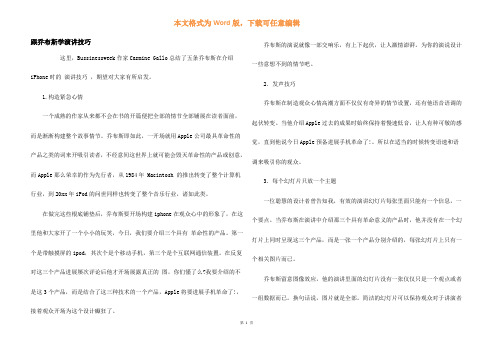
跟乔布斯学演讲技巧这里,Bussinessweek作家Carmine Gallo总结了五条乔布斯在介绍iPhone时的演讲技巧,期望对大家有所启发。
1.构造紧急心情一个成熟的作家从来都不会在书的开篇便把全部的情节全部铺展在读者面前,而是渐渐构建整个故事情节。
乔布斯即如此,一开场就用Apple公司最具革命性的产品之类的词来开吸引读者,不经意间这世界上就可能会毁灭革命性的产品或创意,而Apple那么荣幸的作为先行者,从1984年 Macintosh 的推出转变了整个计算机行业,到20xx年iPod的问世同样也转变了整个音乐行业,诸如此类。
在做完这些根底铺垫后,乔布斯要开场构建iphone在观众心中的形象了,在这里他和大家开了一个小小的玩笑,今日,我们要介绍三个具有革命性的产品。
第一个是带触摸屏的ipod,其次个是个移动手机,第三个是个互联网通信装置。
在反复对这三个产品进展屡次评论后他才开场展露真正的图,你们懂了么?我要介绍的不是这3个产品,而是结合了这三种技术的一个产品,Apple将要进展手机革命了!,接着观众开场为这个设计癫狂了。
乔布斯的演说就像一部交响乐,有上下起伏,让人激情澎湃。
为你的演说设计一些意想不到的情节吧。
2. 发声技巧乔布斯在制造观众心情高潮方面不仅仅有奇异的情节设置,还有他语音语调的起伏转变。
当他介绍Apple过去的成果时始终保持着慢速低音,让人有种可敬的感觉,直到他说今日Apple预备进展手机革命了!。
所以在适当的时候转变语速和语调来吸引你的观众。
3. 每个幻灯片只放一个主题一位聪慧的设计者曾告知我,有效的演讲幻灯片每张里面只能有一个信息,一个要点。
当乔布斯在演讲中介绍那三个具有革命意义的产品时,他并没有在一个幻灯片上同时呈现这三个产品,而是一张一个产品分别介绍的,每张幻灯片上只有一个相关图片而已。
乔布斯留意图像效应,他的演讲里面的幻灯片没有一张仅仅只是一个观点或者一组数据而已。
解读乔布斯的演讲技巧
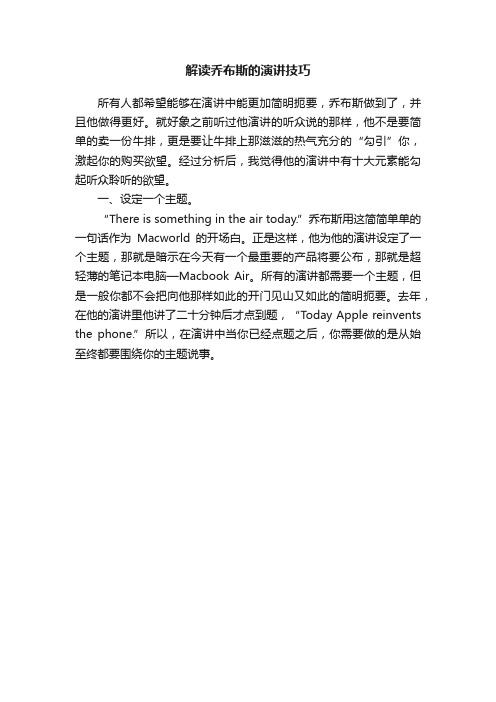
解读乔布斯的演讲技巧
所有人都希望能够在演讲中能更加简明扼要,乔布斯做到了,并且他做得更好。
就好象之前听过他演讲的听众说的那样,他不是要简单的卖一份牛排,更是要让牛排上那滋滋的热气充分的“勾引”你,激起你的购买欲望。
经过分析后,我觉得他的演讲中有十大元素能勾起听众聆听的欲望。
一、设定一个主题。
“There is something in the air today.”乔布斯用这简简单单的一句话作为Macworld的开场白。
正是这样,他为他的演讲设定了一个主题,那就是暗示在今天有一个最重要的产品将要公布,那就是超轻薄的笔记本电脑—Macbook Air。
所有的演讲都需要一个主题,但是一般你都不会把向他那样如此的开门见山又如此的简明扼要。
去年,在他的演讲里他讲了二十分钟后才点到题,“T oday Apple reinvents the phone.”所以,在演讲中当你已经点题之后,你需要做的是从始至终都要围绕你的主题说事。
乔布斯提升演讲肢体语言效果的三大技巧

乔布斯提升演讲肢体语言效果的三大技巧技巧一:保持你的身体直立乔布斯在演讲中总是保持他的身体直立,这不仅展示了他的权威地位,同时也传达出他对演讲主题的信心。
他很少弯腰或倾斜,这使得他看起来更自信、更专注。
技巧二:运用手势乔布斯的手势非常出色,他能够用简单的手势表达出复杂的概念。
他的手势通常从腰部高度开始,这使得观众更容易跟随他的思路。
他也会运用一些特定的手势,如伸出一只手,手掌向上,手指向一个方向,然后再翻转手掌向下,指向另一个方向,以此来表达他对某个观点的强烈支持。
技巧三:保持眼神接触乔布斯非常注重眼神接触,他相信这是建立观众信任和共鸣的关键。
他会在演讲中不断地与观众进行眼神接触,这不仅显示出他对观众的尊重,同时也让观众感到他在与他们共享一个共同的体验。
运用以上三大技巧,你可以提升你的演讲肢体语言效果。
记住,肢体语言不仅仅是你的身体语言,它是你传达信息和情感的方式。
通过运用正确的技巧,你可以更好地吸引观众的注意力,增强你的演讲效果。
当然,除了以上提到的技巧外,还有很多其他的技巧可以帮助你提升演讲的肢体语言效果。
例如:保持微笑:微笑可以传达出你的积极态度和热情,同时也可以吸引观众的注意力。
放松身体:放松的身体姿势可以让你看起来更自信、更放松。
你可以通过调整你的坐姿、站姿或走动来展示你的自信和活力。
运用节奏和步伐:适当的节奏和步伐可以让你看起来更有活力,同时也可以帮助你更好地掌控演讲的节奏和进度。
你可以通过调整你的步伐和节奏来表达你对演讲内容的情感和态度。
总之,肢体语言是演讲中非常重要的一部分,它可以帮助你更好地传达信息和情感。
通过运用正确的技巧和放松身体,你可以提升你的演讲效果,让你的观众更好地理解和共鸣你的观点和情感。
以上就是乔布斯提升演讲肢体语言效果的三大技巧以及一些其他技巧的介绍。
希望这些信息能够帮助你更好地提升你的演讲能力。
记住,肢体语言是一种无声的语言,它可以帮助你更好地与观众建立联系和共鸣。
乔布斯提升演讲效果的七大技巧2
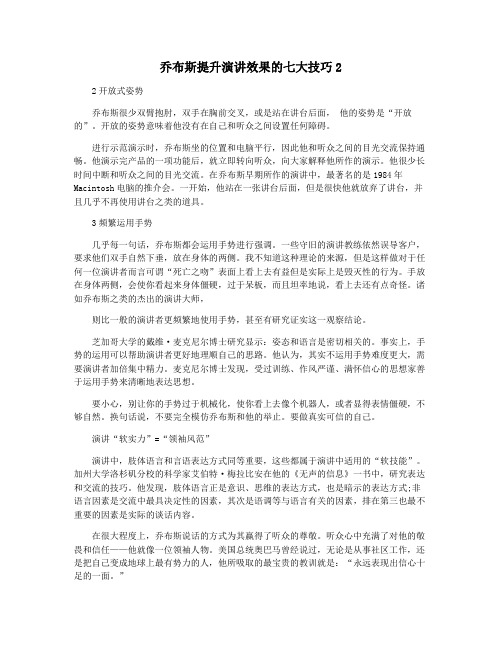
乔布斯提升演讲效果的七大技巧22开放式姿势乔布斯很少双臂抱肘,双手在胸前交叉,或是站在讲台后面,他的姿势是“开放的”。
开放的姿势意味着他没有在自己和听众之间设置任何障碍。
进行示范演示时,乔布斯坐的位置和电脑平行,因此他和听众之间的目光交流保持通畅。
他演示完产品的一项功能后,就立即转向听众,向大家解释他所作的演示。
他很少长时间中断和听众之间的目光交流。
在乔布斯早期所作的演讲中,最著名的是1984年Macintosh电脑的推介会。
一开始,他站在一张讲台后面,但是很快他就放弃了讲台,并且几乎不再使用讲台之类的道具。
3频繁运用手势几乎每一句话,乔布斯都会运用手势进行强调。
一些守旧的演讲教练依然误导客户,要求他们双手自然下垂,放在身体的两侧。
我不知道这种理论的来源,但是这样做对于任何一位演讲者而言可谓“死亡之吻”表面上看上去有益但是实际上是毁灭性的行为。
手放在身体两侧,会使你看起来身体僵硬,过于呆板,而且坦率地说,看上去还有点奇怪。
诸如乔布斯之类的杰出的演讲大师,则比一般的演讲者更频繁地使用手势,甚至有研究证实这一观察结论。
芝加哥大学的戴维·麦克尼尔博士研究显示:姿态和语言是密切相关的。
事实上,手势的运用可以帮助演讲者更好地理顺自己的思路。
他认为,其实不运用手势难度更大,需要演讲者加倍集中精力。
麦克尼尔博士发现,受过训练、作风严谨、满怀信心的思想家善于运用手势来清晰地表达思想。
要小心,别让你的手势过于机械化,使你看上去像个机器人,或者显得表情僵硬,不够自然。
换句话说,不要完全模仿乔布斯和他的举止。
要做真实可信的自己。
演讲“软实力”=“领袖风范”演讲中,肢体语言和言语表达方式同等重要,这些都属于演讲中适用的“软技能”。
加州大学洛杉矶分校的科学家艾伯特·梅拉比安在他的《无声的信息》一书中,研究表达和交流的技巧。
他发现,肢体语言正是意识、思维的表达方式,也是暗示的表达方式;非语言因素是交流中最具决定性的因素,其次是语调等与语言有关的因素,排在第三也最不重要的因素是实际的谈话内容。
乔布斯的十个演讲技巧

乔布斯的十个演讲技巧一、设定一个主题。
“There is something in the air today.”乔布斯用这简简单单的一句话作为Macworld的开场白。
正是这样,他为他的演讲设定了一个主题,那就是暗示在今天有一个最重要的产品将要公布,那就是超轻薄的笔记本电脑—Macbook Air。
所有的演讲都需要一个主题,但是一般你都不会把向他那样如此的开门见山又如此的简明扼要。
去年,在他的演讲里他讲了二十分钟后才点到题,“Today Apple reinvents the phone.”所以,在演讲中当你已经点题之后,你需要做的是从始至终都要围绕你的主题说事。
二、显示出你对主题内容的巨大兴趣乔布斯一直的其门下产品的工业设计为傲,并表现出相当的激情。
在乔布斯过程中,他经常喜欢用一些"extraordinary---非同寻常的," "amazing---精湛的," 还有"cool---酷"这样的词汇来形容他的产品。
当讲到iPhone支持定位新特性时,乔布斯说“这用起来真××爽”。
绝绝大部分的主讲人都会在演讲中给出时间来演示这些亮点。
记住,你的听众们想要得到一种被震撼的感觉,而不是来找个地方睡觉。
所以下次当你在实行演讲的时候,一定记得把你对产品的热爱倾注进去。
如果你觉得你的产品真的很好,那就直接说出来!还有很多的主讲人经常把自己的演讲中的兴奋点去掉。
你能够这样想,如果你自己对你的产品都没什么热情,你的客户会怎么样?三、制造一条主线乔布斯有一次是这样为自己的演说制造主线的,他说“There are four things I want to talk about today. So let's get started…今天有四件事情要告诉大家,我们开始把。
”。
在接下来的整个演说里,他都口头的在开始说每一件事情时都对上一件事情做了一个总结,也点醒将要说的下一件事,其中的转换非常的简要,但是充足让听众理解到接下来他将要说什么。
- 1、下载文档前请自行甄别文档内容的完整性,平台不提供额外的编辑、内容补充、找答案等附加服务。
- 2、"仅部分预览"的文档,不可在线预览部分如存在完整性等问题,可反馈申请退款(可完整预览的文档不适用该条件!)。
- 3、如文档侵犯您的权益,请联系客服反馈,我们会尽快为您处理(人工客服工作时间:9:00-18:30)。
Uncovering Steve Jobs' Presentation SecretsBy Carmine GalloThe Apple music event of Sept. 9, 2009, marked the return of the world's greatest corporate storyteller. For more than three decades, Apple (AAPL) co-founder and CEO Steve Jobs has raised product launches to an art form. In my new book, The Presentation Secrets of Steve Jobs: How to Be Insanely Great in Front of Any Audience, I reveal the techniques that Jobs uses to create and deliver mind-blowing keynote presentations.Steve Jobs does not sell computers; he sells an experience. The same holds true for his presentations that are meant to inform, educate, and entertain. An Apple presentation has all the elements of a great theatrical production—a great script, heroes and villains, stage props, breathtaking visuals, and one moment that makes the price of admission well worth it. Here are the five elements of every Steve Jobs presentation. Incorporate these elements into your own presentations to sell your product or ideas the Steve Jobs way.1. A headline. Steve Jobs positions every product with a headline that fits well within a 140-character Twitter post. For example, Jobs described the MacBook Air as "the world's thinnest notebook." That phrase appeared on his presentation slides, the Apple Web site, and Apple's press releases at the same time. What is the one thing you want people to know about your product? This headline must be consistent in all of your marketing and presentation material.2. A villain. In every classic story, the hero fights the villain. In 1984, the villain, according to Apple, was IBM (IBM). Before Jobs introduced the famous 1984 television ad to the Apple sales team for the first time, he told a story of how IBM was bent on dominating the computer industry. "IBM wants it all and is aiming its guns on its last obstacle to industry control: Apple." Today, the "villain" in Apple's narrative is played by Microsoft (MSFT). One can argue that the popular "I'm a Mac" television ads are hero/villain vignettes. This idea of conquering a shared enemy is a powerful motivator and turns customers into evangelists.3. A simple slide. Apple products are easy to use because of the elimination of clutter. The same approach applies to the slides in a Steve Jobs presentation. They are strikingly simple, visual, and yes, devoid of bullet points. Pictures are dominant. When Jobs introduced the MacBook Air, no words could replace a photo of a hand pulling the notebook computer out of an interoffice manila envelope. Think about it this way—the average PowerPoint slide has 40 words. In some presentations, Steve Jobs has a total of sevenwords in 10 slides. And why are you cluttering up your slides with too many words?4. A demo. Neuroscientists have discovered that the brain gets bored easily. Steve Jobs doesn't give you time to lose interest. Ten minutes into a presentation he's often demonstrating a new product or feature and having fun doing it. When he introduced the iPhone at Macworld 2007, Jobs demonstrated how Google Maps (GOOG) worked on the device. He pulled up a list of Starbucks (SBUX) stores in the local area and said, "Let's call one." When someone answered, Jobs said: "I'd like to order 4,000 lattes to go, please. No, just kidding."5. A holy smokes moment. Every Steve Jobs presentation has one moment that neuroscientists call an "emotionally charged event." The emotionally charged event is the equivalent of a mental post-it note that tells the brain, Remember this! For example, at Macworld 2007, Jobs could have opened the presentation by telling the audience that Apple was unveiling a new mobile phone that also played music, games, and video. Instead he built up the drama. "Today, we are introducing three revolutionary products. The first one is a widescreen iPod with touch controls. The second is a revolutionary mobile phone. And the third is a breakthrough Internet communications device…an iPod, a phone, an Internet communicator…an iPod, a phone, are you getting it? These are not three devices. This is one device!" The audience erupted in cheers because it was so unexpected, and very entertaining. By the way, the holy smokes moment on Sept. 9 had nothing to do with a product. It was Steve Jobs himself appearing onstage for the first time after undergoing a liver transplant.One more thing…sell dreams.Charismatic speakers like Steve Jobs are driven by a nearly messianic zeal to create new experiences. When he launched the iPod in 2001, Jobs said, "In our own small way we're going to make the world a better place." Where most people saw the iPod as a music player, Jobs recognized its potential as a tool to enrich people's lives. Cultivate a sense of mission. Passion, emotion, and enthusiasm are grossly underestimated ingredients in professional business communications, and yet, passion and emotion will motivate others. Steve Jobs once said that his goal was not to die the richest man in the cemetery. It was to go to bed at night thinking that he and his team had done something wonderful. Do something wonderful. Make your brand stand for something meaningful.。
